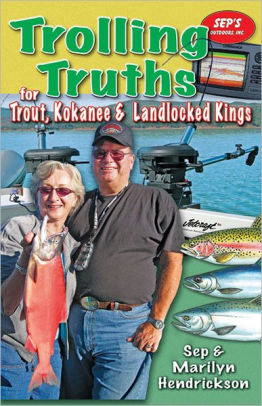 Winter Trophy Trout with Sep Hendrickson
Winter Trophy Trout with Sep Hendrickson
Presented by Fisherman’s Warehouse
As the water begins to cool each year and the lakes undergo their turnovers, big trout are on the feed. Sep Hendrickson wrote a book on the subject with his wife, Marilyn.
“Trolling Truths” covers trolling for trout, kokanee, and landlocked king salmon. They also host the California Sportsmen Radio Show and have spent many winter days chasing big trout. Hendrickson shared some tips on where to go, what to look for and what to use to catch a trophy trout this winter.
 The Time is Now
The Time is Now
Each year as colder winds begin, a change occurs in trout lakes. Lakes stratify into three levels, the epilimnion, metalimnion (also known as thermocline), and the hypolimnion.
The lower level is the hypolimnion and is generally stagnant and lacking in oxygen, the thermocline offers an ideal temperature for trout and other species, and the upper level is the epilimnion.
READ RELATED: Identifying and Understanding the Thermocline
The mixing of the three levels is the key to excellent trout fishing according to Hendrickson.
“Once the winds pick up and start to mix the water layers, the temperature can be the same from top to bottom. This change gives the fish a signal that it is time to feed,” he says and adds that this has been happening since November.
“The ideal days to catch a big trout are when you have stable barometric pressure for two days in a row, whether it is low or high pressure as long as it is stable.”
Where to Find Trophy Trout
There are many California waters with large trout and Hendrickson was able to list several with big fish potential.
“There are so many lakes in California with big trout. Almanor, Eagle, Shasta, New Melones, Oroville, Berryessa, and Don Pedro all have trophy potential,” he says. “The two premier lakes are Lake Almanor and Eagle Lake.”
Catching Winter Trout Seminar with Gold Country Sportfishing | Thursday, Feb 21
When mentioning big fish, Hendrickson says the seven, eight, nine and 10-pounders are what he considers a trophy and says that it sometimes takes a different mindset to fool fish this size.
“Sometimes it takes fishing for one bite all day. Instead of trying to catch ten fish a day, you are looking for one 10-pounder,” he says. For Hendrickson, the best way to trick a trophy is by trolling.
Trolling with Sep
Over the years, Hendrickson has learned that the best way to target big trout is by trolling, being stealthy, and by eliminating excess hardware like dodgers and flashers.
“Big fish get to that size by being smart. You do not need all of that extra stuff; the key is to get them to bite by impulse,” he begins.
Generally, he is pretty basic with what he is trolling and uses a variety of stickbaits and a simple curly tail grub. White, black, brown and amber are all good color choices for the grub, and he prefers a 2” for two- to six-pound fish and 3” if bigger fish are present. He is a believer in scent and often adds Pro-Cure Trophy Trout Bait Sauce that is made from tui chubs that big trout love to eat.
He prefers to monitor his electronics to see where the fish are located and use his electronic downriggers to adjust his lures while trolling. Hendrickson prefers Scotty Downriggers but says the key is to use one that is accurate.
“The downriggers now are so quick that you can intercept fish you see on your graph and raise or lower to where they are before the bait gets to them while you are trolling,” he says.
He will troll at any depth he needs and says it can be 12” below the surface or 100-feet deep, as long as the bait is just above the fish. It is dependent on where the fish are, and he locates possible areas by using his map.
“Steep drops, creek channels, rocks, and points are all good places to look,” he says.
Trolling speed is another variable, and it can be anywhere from a 0.8 to 1.3mph with an electric trolling motor to a 2.5-4mph with a large outboard.
“If the big fish are eating small trout and kokanee, I like to use a three to five-inch stickbait and troll faster because I don’t want them to get a good look at the lure.”
Another tip he shared was to troll far behind the boat if possible.
“The fish are listening, and all the boat noise and music playing from the radio all let fish know you are there. If you can troll 150- to 200-feet behind the boat that dissociates the boat noise to the bait the fish are seeing,” he believes.
If you are looking for a trophy trout, now is the time and thankfully there are plenty of good waters available to make it happen. Sep Hendrickson has caught many big trout, and his methods hold for all forms of trophy hunting: be stealthy, understand your target species, and maximize your efficiency.
Shop these baits and more at Fishermans Warehouse Megastore


 Advertising
Advertising